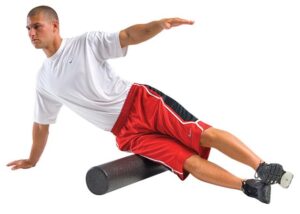
Foam rolling for muscular pain. Some tips on self-application of myofascial release
Many of our patients are aware of the benefits of myofascial release treatment, which comes in different styles such as Active Release Techniques (r), Barnes among other methods that are well accepted. When combined with chiropractic treatment and rehabilitation, they are used to exceptional outcomes.
Many people are also finding that foam rollers for the application of self-myofascial release treatment is also helpful, sometimes more than Yoga and other self-help methods.
Athletes are finding that foam rolling improves their performance, decreases after-workout pain, and gives them a good option for taking care of their own muscular needs, reducing their reliance from other methods. ESPN recently offered some advice and information on Myofascial Release. Read the article here:
ROLL OUT TO EASE THOSE ACHING MUSCLES
By Christine Yu | Apr 10, 2014
We all know how good a massage feels after an intense workout or a week of training, but not all of us have a personal masseuse on call. Instead, many athletes are taking things into their own hands.
From weekend warriors to professionals, athletes are using foam rollers, lacrosse balls and massage sticks to work out the kinks in their muscles themselves. It’s a practice called self-myofascial release.
Self-myo-what?
“Myofascia is what’s also known as your connective tissue,” says John Osika, licensed massage and bodywork therapist and owner of Carolina Massage Therapy. “It’s the webbing within the body that holds all the structures in place and wraps around your muscles and organs. When there’s trauma to an area, it becomes very sticky and everything under the skin feels tight.”
Osika likens fascia to cling wrap — it clings to itself until you can flatten it out. That’s where myofascial release techniques like foam rolling come in.
“Traditionally, when we think of myofascial release, we usually think of a practitioner [working on] a client. You are trying to create some type of change — in length or dimension — to the soft tissue in your body. With the self-myofascial release, you are the agent of change in your soft tissue,” using an object like a lacrosse ball, says Jill Miller, creator of Yoga Tune-Up and co-founder of Tune Up Fitness Worldwide. “The tools can really get in there and manipulate the tissue in small, nuanced ways.”
“The idea is that you have adhesions. The connective tissue that surrounds the muscles have some tightening and scar tissue,” says Carolyn Peters, head athletic trainer and strength coach at San Diego Christian College. According to Peters, when your connective tissue is tangled up, it restricts your movement and range of motion, which could ultimately affect your performance.
In addition, Osika says that “when [your myofascia] is bound up, you lose hydration and blood flow in that area.”
read more here
What type of foam roller is best?
We suggest the small roller from the trigger point company since it is hollow and will never warp. It is also light, fits easily in a gym bag, is well-cushioned for comfort and it has nubs on it to keep it from rolling around when you place it between your body and the floor or bed. Foam rolling should never be painful, but soreness at the point of restriction or adhesion is expected. Deeper myofascial release treatment should only be done by a professional since most of us are poor judges of which areas are actually the problem areas, which is why we recommend that you always work on both sides for the best therapeutic effect. The foam roller otherwise known as The Grid from Trigger Point Performance can be purchased from our office or through other retailers.
What is the best way to apply a foam roller?
Our office has two videos; one for the lower body and the other for the upper body. Our methods are different since we do not advocate working deeply with a roller. Since the myofascial is superficial, it makes sense the roller should be applied the same way.
Here are two videos we have on our youtube channel. Watch them as much as you want so you can learn the techniques we offer. Note, the roller we recommend (the upper body rolling video is using the trigger point roller).
Upper body foam rolling
Lower body foam rolling